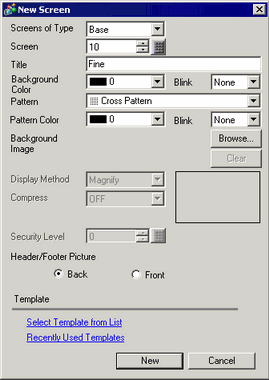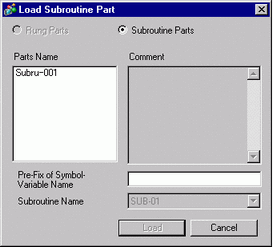
To create a new screen, from the [Screen (S)] menu, select [New Screen (N)].

Screens of Type
Select the screen type to create or select a template from [Base], [Window], or [Logic].
Screen
If [Screens of Type] is set to [Base] specify the screen number from 1 to 9999, if set to [Window] specify from 1 to 2000, or if set to [Logic] specify from SUB-01 to SUB-32.
Title
Set the screen title, up to 30 characters, for the new screen.
Background Color
Defines the background color for the screen.
Blink
Select whether or not Background Color will blink, and the blink speed. You can set this up for the [Background Color] and [Pattern Color].
Pattern
Defines the pattern for the screen.
Pattern Color
Select the pattern color.
Background Image
Click [Browse] to select an image (supported formats BMP, JPEG, PNG, DPD) as the screen background image. Click [Clear] to delete the selected image.
Display Method
The background image display options are [Stretch] or [Center].
Compression
Defines whether to compress the size of the background image.
Header/Footer Picture
Select the Header/Footer drawing order from [Back] or [Front]. You can set this up when in the [Project Information] dialog box, [File Information] page, the [Enable Expert Mode] check box is selected. This setting is available on Base screens only.
Security Level
Set the screen's security level.
To use this setting, from the [Common Settings] menu, point to [Security] and select [Security Password]. In the Passwords page, select the [Enable Security Function] check box. 22.2.1 Creating Limited Access Screens
22.2.1 Creating Limited Access Screens
Backlight Color
When using GP-4100 series, you can select the backlight color from [Green/White], [Red], and [Orange/Pink]. This setting is available on Base screens only.
Backlight Blink
When using GP-4100 series, you can set the backlight to flash intermittently.
Use Template
Select a template.
Select Template from List
Displays the [Select Template] dialog box to select a template.
Recently Used Templates
The names of recently used templates are displayed as popup.
This setting appears when you select [Logic] in [Screens of Type].
When you newly create a logic screen of a subroutine, you can call the subroutine parts registered as logic parts.
Select Subroutine Parts
Select the registered subroutine parts to create a subroutine program.

For more information on [Load Subroutine Part], see the following.